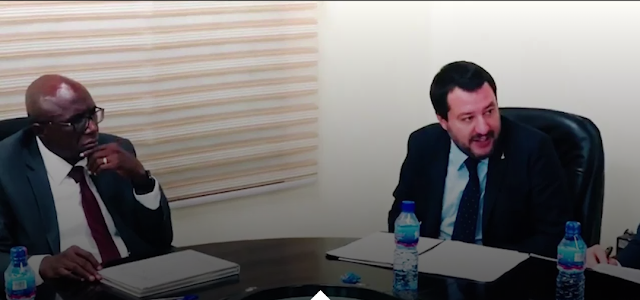UPDATE ON THE SALVINI'S TRIP TO GHANA
Matteo Salvini flew on 5 and 6 November in Ghana for a flash mission. Ignored by the majority, the mission had the purpose, according to the League representative, of the signing of an "agreement with the government to control immigration and guarantee a future of study and work for those children, but in their country". The announcement in a tweet. In Accra, the pro tempore minister met his Ghanean counterpart Ambrose Dery and the president of the country Nana Akufo-Addo, who denied Salvini's enthusiastic comments on the outcome of the trip. The main local newspaper, Ghanaians times, titled the day after the meeting: "The president furious for the inhuman treatment of African migrants". And on the inside pages his hard sentences against Salvini are reported: "One should not hide behind the pretext of combating irregular migrations to commit abuses against irregular migrants".
But Salvini's journey proved extravagant for another aspect. In fact, he went to the African country that exports less migrants and is among the most stable in Africa. It is the second largest economy in the Economic Community of West African States (Cedeao). Since 2010 it is considered a middle income country.
The Ghaneans in Italy, as Marco Scarpati reminds us in his post on Facebook, "are, in total, just under 49 thousand. And their presence is substantially stable, if it is true that in 2010 there were 47 thousand. They represent 0.97% of the total number of migrants. They do a few crimes and are excellent workers, mostly engaged mainly in factories in northern Italy. Very few irregular people ".
Question: why the "free-range" minister has chosen for his propaganda, through the fanfare of social networks, the wrong country? Nobody pointed it out to him? Was it a case? Or, is an African country worth the other for its propaganda pulpit?
But it is another question that most we want to submit to Salvini: his trip has planned a stop on the Cape Coast or Elmina? Certainly he will at least have heard of these two places of memory overlooking the ocean, a hundred miles from Accra. Cape Coast was the most important center for the slave trade in all of West Africa. A symbolic place, protected by UNESCO. In its fortress the prisoners, in millions, were exposed to it and the buyers chose the best pieces at auction: only the healthiest and strongest women and men.
The "doors of non-return" are dozens in Africa. Ghana is perhaps the country with the highest concentration. The entire Gulf of Guinea, or the coast between the delta of Niger and Ghana, was renamed Costa degli Schiavi, and the chain of forts and castles that extends along its coastline is an extraordinary historical document.
15 km from Cape Coast, there is the port town of Elmina. Up to 300 prisoners, hands and feet in chains, plunged in their droppings, held for months before being boarded as slaves, were piled up in its underground prisons. Those who died of sickness, hunger and thirst were thrown into the sea. Those who tried to escape were cut off their ears and then locked up in the cell of death.
Images that seem stolen from today's Libyan concentration camps, where the bodies of hundreds of thousands of migrants are crowded. Bodies, not people.
Barak Obama's first trip to Africa, July 10-11, 2009, was in Cape Coast, a tribute to his history and to places where Western values have shrunk.
Salvini, who shows himself to be a politician so obsessively passionate about the issue of migrants and people on the run, has felt the need to visit, in her Ghanaian blitz, those rooms where hopes died even before they were born?


evidence of a jobless man with no vision
ReplyDelete